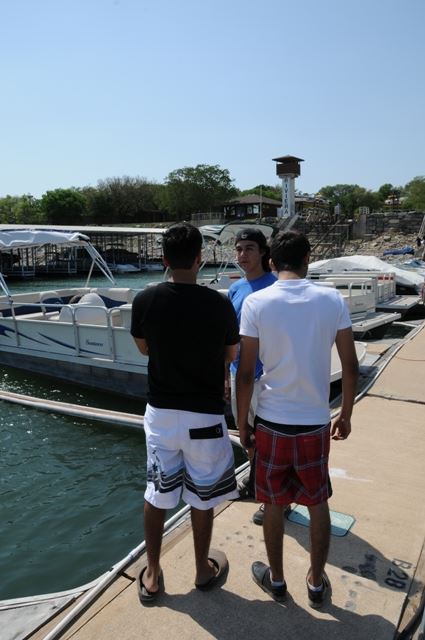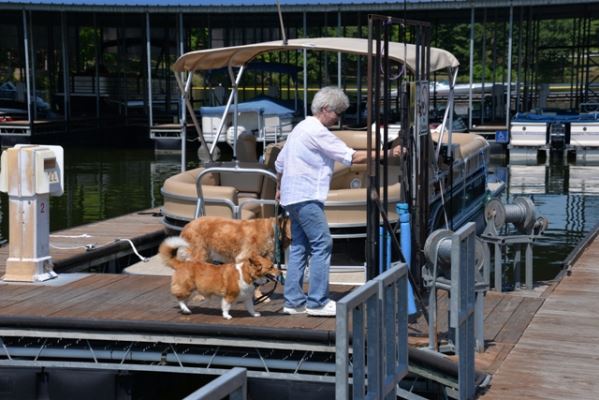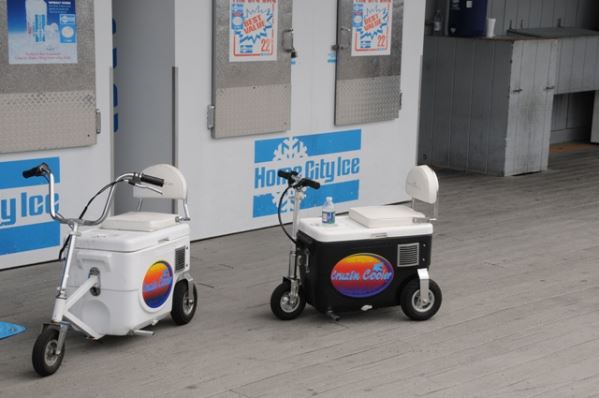
I Learned About Boating from that-OODA loop
Now, I am no fighter pilot for sure, its been over a decade since I’ve flown a plane as Pilot-in-Command, and I have had my share of bumps and scrapes in boats and will likely have more. But when I am behind the helm, this is the process that I am continually thinking about and, whenever waste comes in contact with rapidly spinning airfoils, I immediately and consciously use this to “work the problem.” The process? The OODA loop.
- Mindy Goodman
- Tags: Boating Boating Safety safe boating habits

Getting your Lover to love Boating
Statistics prove sharing hobbies with your spouse is a key factor in having a successful marriage. The more you’re able to do together as a couple, the happier you’ll both generally be. But in marriage, as in life, there are always compromises. It can be as simple as surrendering the remote to Bachelor in exchange for the NFL Sunday Ticket football package. Or something a little more permanent like going with the mini-van when you had your heart set on the SUV.
Not all hobbies can (or should) be shared, but pontooning is definitely one activity that can best be enjoyed with your spouse. But even though boating can be one of the most enjoyable and rewarding experiences of your life, there can be a right way and a wrong way to introduce your spouse into boating.
Generally speaking they say you’ll go out 10 times before it happens—that perfect boating experience—and you’ll keep going out nine times more to recapture that magic. If you’d like your spouse to enjoy the pontooning life as much as you, it’s important to plan your introduction correctly. The secret to creating a successful boating partnership is to use some of the following ideas to encourage your partner, and make the dream as much hers as it is yours.
1. Start Slowly
Gaining trust and confidence can go a long way and it’s important to show your spouse you have the knowledge and skills to correctly operate a pontoon. If you happen to be new to boating, make sure your first trips build that confidence. Choose calm weather days when your lake is less crowded and keep your itinerary simple.
Anyone with a little money can buy a pontoon and learn the basics of how to maneuver it. But it takes time and varied experiences to become proficient so you react correctly and calmly in a variety of situations. If you take the time to learn and practice before attempting anything ambitious, you’ll avoid confidence-sapping situations that could destroy your dream of boating with your partner.
2. Mistakes Welcomed
.jpg_600.jpg) Most boating skills tend to deteriorate when you’re being coached constantly, especially when it comes to helm time. Often your spouse becomes too focused on what you might criticize next, instead of driving. We’re only trying to keep our partner from making the same mistakes we made starting out, but sometimes that’s the only way she is going to truly learn.
Most boating skills tend to deteriorate when you’re being coached constantly, especially when it comes to helm time. Often your spouse becomes too focused on what you might criticize next, instead of driving. We’re only trying to keep our partner from making the same mistakes we made starting out, but sometimes that’s the only way she is going to truly learn.
Plus, by allowing for mistakes without letting it ruin your day, you’ll also make life afloat more pleasant for your partner. Pontoons are tough and forgiving. Don’t let a misjudged dock approach become a big deal. Remember, boats are far easier to mend than broken relationships.
3. Positive Reinforcement
Face it: enthusiasm is contagious. Instead of focusing on lectures, books or movies that emphasize the negative aspects of boating, look to include as many positive-reinforcement opportunities as you can. Plus have your wife talk to other female pontooners and the enthusiasm is sure to grow.
4. Off Peak
While you’re still gaining your spouse’s confidence, avoid entering the dock at peak hours. When you come into the dock, all eyes are on you and the slightest mistake can escalate your anxiety, especially if you’re trying to come into your slip during the busiest time of the day. Sometimes it’s better to let the rush die down or at least let the wind eases up a little to ensure a smoother experience.
If you’re planning to anchor, forget trying to find a spot close to shore where it’s crowded. Try anchoring a little farther out, even if it means a longer dinghy ride ashore. Picking a less busy day of the week to practice docking, anchoring, and mooring procedures without spectator pressures is a great way to not only build confidence, but to also help develop your own communication plan.
Knowing ahead of time what your spouse’s role will be as you come into the dock will help relieve some of that pressure. But above all, discuss and accept the pressures that observers create and don’t let this chip at the confidence you’re trying to build in your partner.
5. Discuss Yelling
.jpg_600.jpg) Guys see yelling as just another form of communicating, especially when wind or other situations make it difficult to communicate effectively, while some women feel yelling is reserved for times of anger or fear. It’s important to candidly discuss the difference because the memory of raised voices tends to linger in a woman’s mind long after the incident has passed.
Guys see yelling as just another form of communicating, especially when wind or other situations make it difficult to communicate effectively, while some women feel yelling is reserved for times of anger or fear. It’s important to candidly discuss the difference because the memory of raised voices tends to linger in a woman’s mind long after the incident has passed.
Here is one scenario that should be talked about: You’re coming into the dock and the wind is picking up. How can you make sure she hears you without yelling? Practice helps, especially when it comes to developing hand signals.
Try calling “very loudly” and then having the other person repeat the order so that each person knows the other heard and understood. Finally, be ready to accept that some instances of yelling are caused by your own tension/apprehension, real or imagined. Apologize sincerely once the situation is under control and explain that no anger was intended so you can work toward developing into a better boating team.
6. Outside The Box
Sometimes you need to get a little creative when you’re trying to entice your partner into the boating life. Take a closer look at her hobbies and incorporate those interests into your time on the water. If she loves dining out, she’ll love the experience of going into restaurants by boat. In no time your partner will connect boating with her interests and view the pontoon as a vehicle that opens her to new experiences that she loves.
7. Back Up Planning
One concern for many spouses is the fear of operating the pontoon themselves. She may not know how to troubleshoot with the engine. One major fear for some women is how they’d bring the boat home should the engine give out, or something happen to the skipper. Some boating schools now offer courses on how to bring your boat back into port alone, anchor, then contact assistance should a partner be out of commission.
8. Honesty
.jpg_600.jpg) Despite what photos and advertisements might lead you to believe, pontooning isn’t always easy, and isn’t always romantic. If you lead your spouse into thinking otherwise, you’re leading yourself astray, too. Let’s be honest: boating is physical. You must carry everything you use from the shore to the boat. You have to store things so they don’t get loose and blow out while underway. This means you’ll always need to move one thing to get something else, which is a hassle. When you actually set off on a cruise, learn to give each other physical and mental space. Be realistic, and talk about it more as an intimate adventure that will connect you to nature.
Despite what photos and advertisements might lead you to believe, pontooning isn’t always easy, and isn’t always romantic. If you lead your spouse into thinking otherwise, you’re leading yourself astray, too. Let’s be honest: boating is physical. You must carry everything you use from the shore to the boat. You have to store things so they don’t get loose and blow out while underway. This means you’ll always need to move one thing to get something else, which is a hassle. When you actually set off on a cruise, learn to give each other physical and mental space. Be realistic, and talk about it more as an intimate adventure that will connect you to nature.
Recap
Following the suggestions in this article is a good step in the right direction to getting your spouse to love pontooning like you do, but don’t be afraid to make your own adjustments and personalize these tips to your own needs.
Above all else it’s important to establish a sense of interdependence, create your boating goals together, trust each other when the going gets rough and of course establish good communication methods. Communication is the key to good boating partnerships. Combine learning how to communicate afloat with some confidence-building boating experiences, and you’ll increase your partner’s enjoyment and sense of self-sufficiency.
This article is courtesy of Pontoon and Deck Boat Magazine. For this and more articles, visit their website at pdbmagazine.com
- Mindy Goodman
- Tags: Boating couples pontoon pontoon boat

Do You Have Dock Etiquette?
Have you ever been walking down the dock to your pontoon, and there right in the middle of the main walkway is a pile of stuff from someone else’s boat? You look around and don’t see them anywhere, just their stuff. In addition, you can’t get your own dock cart of boating supplies (along with the dog, ukuleles and the cooler) past the “dock block” without moving something. Here’s a question: should you move someone else’s stuff?
Guess this might bring up a bigger topic…dock etiquette.
Let me clarify: I am not the greatest at etiquette. Just in the last few years, I learned about holding your hands up in front of the table setting, the left hand looks like a small “b” for bread, and the right hand looks like a small “d” for drinks. This newfound knowledge has saved me a number of times from messing with someone else’s drink. However, in the grand scheme of etiquette, I needed to look up the definition.
Which is, “A code of behavior that delineates expectations for social behavior according to contemporary conventional norms within a society, social class, or group.”
 If I have this right, the group is “boaters on my dock” and the social behavior I am looking for is “What’s the correct behavior on my dock?”
If I have this right, the group is “boaters on my dock” and the social behavior I am looking for is “What’s the correct behavior on my dock?”
There are a couple of twists to this. If someone, like a property owner, owns the dock on a lake, it is not my dock and the owner can set the rules. That’s pretty straightforward.
But what about those of us who rent a slip on a dock at a marina? My dock has pontoons, wakeboard boats, sailboats and more. Each has a different set of operating ideas and etiquette. There are basic dock rules as stated by the marina, but there are lots of people who do things way different than me. I am not saying their way is wrong, but it’s not what I would do and I wish they wouldn’t do it that way. But, that’s just me, so is there a correct way?
 But, a couple boats down, the owners decided they don’t even care where the extra line goes, so it ends up on the dock often where your dock cart wheels have to run over it. I don’t know about you, but I have been found coiling other people’s lines, for safety reasons, to keep them out of the way.
But, a couple boats down, the owners decided they don’t even care where the extra line goes, so it ends up on the dock often where your dock cart wheels have to run over it. I don’t know about you, but I have been found coiling other people’s lines, for safety reasons, to keep them out of the way.
And there is this new trend on the docks that is some kind of a “daisy chain” looping process, which does shorten the extra line, but the stiffer straight-line of excess rope is even harder to get your dock cart over. I do use the same looping process for extension cords at home. It makes it a lot easier to pull one end and it doesn’t get tangled, but it still gets in the way on the docks.
Then there are the loading/unloading piles. You have probably all seen this before. Walking to your boat, there in the middle of the dock is a pile of coolers, clothes and kids. The boat owners are on the boat, cleaning, covering and doing whatever else they need to do before the get on or off. But in the meantime the dock is full blown LA traffic-jammed. I’m not saying I don’t do the same kind of thing sometimes, but I do try and leave a passing lane.
 One other thing that kind of gets me: I’m out on the water and when I get back to my slip the boater next to me has loaded up the docks with chairs and coolers, making it difficult for us to step off our boat safely.
One other thing that kind of gets me: I’m out on the water and when I get back to my slip the boater next to me has loaded up the docks with chairs and coolers, making it difficult for us to step off our boat safely.
Guess this makes me sound like I am one of those old “crotchety” guys trying to keep the kids off my dock, but believe me I’m not. I just wish everyone who used the docks thought about other people using the dock and left room, or picked up after themselves etc.
*This article is courtesy Pontoon and Deck Boat Magazine. It is written by Scott "Sky" Smith. For this and more, visit pdbmagazine.com
- Mindy Goodman
- Tags: bad boating habits Boating boating etiquette docking

How To Clean and Protect Your Graphics
No longer limited to pontoon, waterski and bass boats, head-turning vinyl graphics are everywhere these days, from luxury cruisers to sailboats. Whether it's an outboard engine logo, colorful image or entire hull wrap, they need specialized care. Shurhold Industries offers a few Clean-N-Simple Tips to keep graphics looking their best for years to come, with minimal effort.
.JPG_600.jpg)
The first step is to begin with a clean hull. Avoid pressure washers and instead opt for a deck brush with a combination head. These have soft bristles for general use around the vinyl and medium for scrubbing stubborn stains such as the waterline.
.jpg_600.jpg)
If the boat needs waxing, mask-off the vinyl with blue painters tape. Many products have built-in cleaners that are ideal for paint and gelcoat, but can degrade graphics. It also protects the edges of the graphic or wrap from lifting if using a polisher.
With the tape removed, spray the vinyl with a detailing product such as Shurhold's Serious Shine. It cleans accumulated dirt, polishes without abrasives and protects from the ravages of UV rays in one easy step. It also repels water to keep unsightly spots from forming. Simply wipe over the area with a microfiber towel, turn the cloth and lightly buff. The more often it's applied, the longer the graphics will last.
One-step quick detailers like Serious Shine also work on touch screens, clear coat, metal, glass and rubber. Above and below deck, it cleans a wide range of surfaces without leaving a greasy residue. Made in the
Dedicated to educating boat owners, Shurhold provides key tips for boat value preservation at www.shurhold.com. Inventor of the One Handle Does It All system, Shurhold manufactures specialty care items and accessories to clean, polish and detail.
This article is courtesy of Pontoon and Deck boat Magazine, for this and more helpful information, go to pdbmagazine.com
